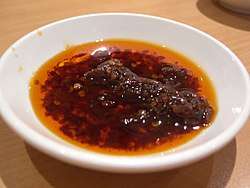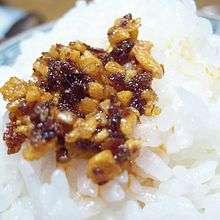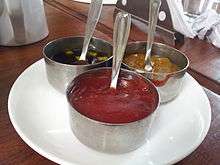Chili oil
 | |
| Alternative names | Hot chili oil, hot oil |
|---|---|
| Type | Dip |
| Main ingredients | Vegetable oil, chili peppers |
| Chili oil | |||||||
| Chinese name | |||||||
|---|---|---|---|---|---|---|---|
| Traditional Chinese | 辣油, 紅椒油, 紅油, 辣椒油, 紅辣椒油, 油泼辣子 | ||||||
| Simplified Chinese | 辣油, 红椒油, 红油, 辣椒油, 红辣椒油, 油潑辣子 | ||||||
| |||||||
| Vietnamese name | |||||||
| Vietnamese | ớt sa tế, ớt satế | ||||||
| Thai name | |||||||
| Thai | น้ำมันพริก | ||||||
| RTGS | nam man phrik | ||||||
| Korean name | |||||||
| Hangul | 고추기름 | ||||||
| |||||||
| Japanese name | |||||||
| Kanji | ラー油, 辣油 | ||||||
| |||||||
Chili oil is a condiment made from vegetable oil that has been infused with chili peppers. It is commonly used in Chinese cuisine, East and Southeast Asia and elsewhere. Particularly popular in Sichuan cuisine, it is used as an ingredient in cooked dishes as well as a condiment. It is sometimes used as a dip for meat and dim sum. It is also employed in the Korean Chinese noodle soup dish jjamppong.
Chili oil is typically red in color. It is made from vegetable oil, often soybean oil or sesame oil, although olive oil or other oils may be used. Other spices may be included such as Sichuan pepper, garlic, or paprika. Commercial preparations may include other kinds of oil, water, dried garlic, soy sauce, and sugar. Recipes targeted to Western cooks also suggest other popular oils such as rapeseed, grapeseed or peanut, and any dried or fresh chili peppers. The solids typically settle to the bottom of the container in which it is stored. When using chili oil, the cook or diner may choose how much of the solids to use; sometimes only the oil is used, without any solids.
Chili oil is commercially available in glass jars, although it may also be made from scratch at home.[1] It is usually available by request at Chinese restaurants.
China
Chili oil has various names in China. It is called 油潑辣子 (chili pepper splashed with oil) in Shaanxi province and 辣油("spicy oil") or 紅油("red oil" ) in Sichuan province. Among those names the most popular one is 辣椒油("chili pepper oil").
In China, chili oil is prepared basically by pouring hot vegetable oil slowly on chili pepper powder or chopped chili pepper.[2] Many other ingredients can be added alongside to enrich flavor such as Chinese black vinegar, minced garlic, dried ginger skin, sesame seeds, sesame oil, Sichuan peppercorn, cinnamon, star anise and bay leaf.[3] There are also many derivative condiments from chili oil, one of which is Lao Gan Ma that is produced from chili oil and Douchi (豆豉, fermented black soybeans).
Chili oil can be consumed directly with other food. Besides, it is also used extensively in cooking all over China especially in Shaanxi cuisine, Sichuan cuisine and Hunan cuisine. Like Hóngyóu chāoshǒu (紅油抄手, wonton in red oil) and Dàn dàn Noodles (擔擔麵).
Japan

The Japanese variety of Chinese chili oil is known as rāyu (ラー油 or 辣油), used in Japan as a cooking ingredient or as a condiment. The default kind is typically a clear, chili-infused sesame oil, and the chopped chili pepper used is typically red, imparting a reddish tint to the oil.[4] Other ingredients used may include soy oil, corn oil, dried aloe, ginger, guava leaves, leek leaves, paprika, and turmeric.
Beginning in 2009, a new type of product known as taberu rāyu (食べるラー油 or -辣油, literally, "rāyu for eating") became a trend in 2010.[5][6] This variety is known for reduced spiciness, and in addition to the usual oil, chunks of food are included such as fried garlic and fried onion.[7]
Italy
The Italian variety of chili oil (olio di peperoncino) originates from the southern region of Calabria. This variety of chili oil uses olive oil as a base, and has a unique brine flavor.
